A 3D-printed rocket will take off for the first time on Saturday from Cape Canaveral, Florida, for a maiden flight that, if successful, could help revolutionize the launch industry.
The rocket, called Terran 1, is developed by the company Relativity Space. The shooting window runs from 1:00 p.m. to 4:00 p.m. local time.
The purpose of this first test flight is to show that the machine can withstand the pressure of a takeoff and recover as much data as possible for the further development of these rockets, which are cheaper and easier to manufacture, according to the company.
multiple benefits
In total, 85% of the rocket’s mass was 3D printed, and the company is targeting 95% in the future.
The advantages are multiple: cost reduction and simplification of the manufacturing process, while offering greater flexibility. With its large 3D printing robots, the company claims to divide the number of parts by 100 compared to a traditional rocket. The speed of the method also stands out: 60 days, from the raw material to the finished product.

The Terran 1 rocket is 33.5 meters tall, with a diameter of just over 2 meters. Its first stage has nine engines, also 3D printed, and its second stage, one engine.
A first launch attempt was called off at the last minute on Wednesday due to a technical problem.
It uses metalox as fuel, a mixture of liquid oxygen and liquefied natural gas (essentially methane). If it manages to reach Earth orbit on Saturday, it would be the first rocket using this fuel to do so.
The goal of a multiplanetary humanity
Relativity Space, which has a long-term vision of participating in the development of a multi-planetary humanity, argues that it is the fuel “of the future”, and the easiest to produce on Mars.
United Launch Alliance’s Vulcan and SpaceX’s Starship rockets under development will also use this fuel.
The Terran 1 rocket must be able to place 1250kg into low earth orbit. But this first flight contains no payload.
Relativity Space is also developing a larger rocket, the Terran R, capable of carrying 20,000kg to low orbit. A release date is not expected before 2024.
1.650 million contracts
The Long Beach-based company has already signed $1.65 billion in contracts, according to Tim Ellis, the young boss of the company he co-founded in 2015.
Most of these contracts concern the larger Terran R rocket. One of them was signed with the company OneWeb, which wants to provide Internet access from space thanks to a constellation of satellites.
This type of rocket “medium-heavy is clearly where the most important market opportunity is for the rest of the decade, with severe shortages currently in this payload class,” Tim Ellis tweeted Tuesday.
A satellite operator can wait years before getting a place on the big Arianespace or SpaceX rockets. Dozens of startups have entered the small and medium rocket market in recent years to meet the demand.
Source: BFM TV

